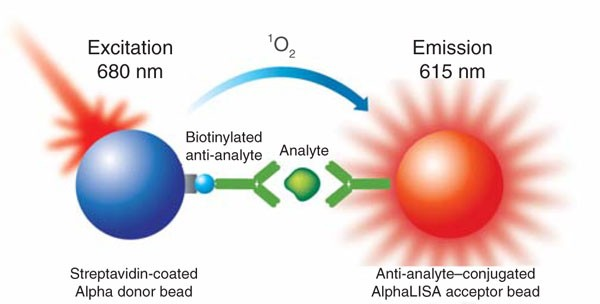AlphaLISA & AlphaPLEX
Amplified Luminescent Proximity Homogeneous Assay
AlphaLISA immunoassays are homogenous bead-based luminescent amplification proximity assays that are highly sensitive and offer a wide dynamic range while requiring only small sample sizes. This proximity assay generates a luminescent or fluorescent signal after energy transfer occurs between molecule-bound Acceptor and Donor beads. Donor beads contain the photosensitizer phthalocyanine, which converts ambient oxygen into a reactive singlet oxygen species when illuminated at 680 nm. The excited singlet oxygen has a half-life of 4 µsec and can diffuse approximately 200 nm in solution. If an Acceptor bead is within this range, the energy is transferred and converted into a measurable luminescent signal at 615 nm. In the absence of Acceptor beads, the singlet oxygen falls to its ground state and no signal is produced.
These assays are versatile and compatible with a variety of sample types, including serum, plasma, cerebrospinal fluid (CSF), tissue extracts, cell culture supernatants, and cell lysates. They can be applied to diverse research areas such as enzyme activity studies, receptor-ligand interactions, ion and second messenger signaling, as well as investigations involving DNA, RNA, proteins, protein–protein interactions, peptides, and small molecules. In addition, AlphaLISA assays are adaptable to high-throughput formats, with options for 96-, 384-, and 1536-well plates, making them ideal for large-scale screening applications.
AlphaPLEX is similar to AlphaLISA since it is also a homogenous luminescent proximity assay, but it can analyze multiple analytes in a single well by using multiple Acceptor beads. These analytes can range from small to large proteins in rare biological samples, such as primary or stem cells.
AlphaPLEX technology is highly versatile and can be applied to a wide range of research areas. It is commonly used for PD/PK biomarker studies and for analyzing stem cell biomarkers, providing sensitive and reliable detection even in complex biological samples. The platform also supports the study of epigenetic markers, such as distinguishing total histone levels from specific modifications.
In addition, AlphaPLEX is valuable for investigating amyloid peptides and conducting IgG profiling or testing. It also enables assay normalization with housekeeping proteins, ensuring consistent and accurate measurements across different experiments.
Advantages of AlphaLISA over Traditional ELISAs
✔ Cytokine and biomarker detection
✔ Cellular epigenetic marker analysis
✔ Cellular phosphorylation studies
AlphaLISA offers significant advantages over traditional methods: no wash steps, faster results, and minimal sample requirements (~5 μL). It delivers a wider dynamic range (up to 5 logs), higher sensitivity, and robust multiplexing capabilities, while also enabling the study of large protein complexes.

When excited at 680 nm, Donor beads release singlet oxygen that activates nearby Acceptor beads only in the presence of the target analyte, producing a luminescent signal at 615 nm. This proximity-based reaction enables sensitive, wash-free detection.
Example Data

For more information about our AlphaLISA platform or the different AlphaLISA kits available, please contact info@axelabio.com